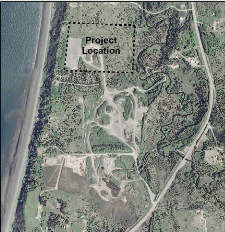
BlueCrest Energy is continuing preparations to drill for oil in the Cosmopolitan Unit at its 37.5-acre site on the Cook Inlet bluff about 5.5 miles north of Anchor Point.
Larry Burgess, health, safety and environmental manager for the Texas-based BlueCrest, told the Kenai Chamber of Commerce on Wednesday that the company’s 3,000-horse power drilling rig is nearing completion in Houston, Texas.
It should ship out for Alaska soon and will take 45 days to arrive, at which point crews will go to work getting it assembled and running.
“Once it gets here I think it will be the largest operating rig in the state of Alaska, capable of drilling up to 30,000-foot-long wells,” Burgess said.
All 10 of the injection oil wells in the inlet will be directionally drilled from onshore. The wells will have a vertical depth of 7,000 to 7,500 feet and could extend out as much as 25,000 feet.
“So these are very challenging and difficult wells to drill,” Burgess said.
The oil will be shipped up the Sterling Highway to Tesoro for processing.
Burgess said the site currently employs 48 people. Local hires have comprised about 60 percent of the workforce, until recently when that ratio has dipped to under 50 percent. The main contractor handling construction is Elkhorn Holdings, from Wyoming, but most of the subcontractors are local.
“We’re trying real hard to hire as many locals as possible but, believe it or not, it’s not as easy as you’d think for some of those jobs,” Burgess said.
While the construction phase is wrapping up, the community engagement process continues. Unlike Burgess’ previous experience on the North Slope, where the nearest neighbor was 40 miles away, at the Anchor Point site there’s a cabin less than 50 years from the pad, and other homes not far away from that.
“Now, when you’ve got a 3,000-hp rig sitting on this pad, some turbines generating electricity, some generators and trucks with backup alarms running 24 hours a day, you’re impacting your neighbors,” Burgess said. “There’s nothing you can do about not impact them, it’s what we can do to minimize the impact.”
He’s been meeting regularly with the immediate neighbors, as well as holding community meetings in Homer, Anchor Point and Ninilchik. He said the discussions have led to some decisions to mitigate the impacts on neighboring residents.
The site needs about 10,000 gallons of water a day just to operate the camp, but residents were concerned that if the company drilled a water well, it could deplete the local aquifer.
“So we made a conscious decision to not drill any water wells and we are having all that water hauled in by a local contractor on the southern peninsula, and that is at no small expense,” Burgess said. “Once we get drilling we may look at drilling a very deep water well on the pad, 7,000 to 8,000 feet deep, which would, of course, have no impact on the local, 100-foot aquifer.”
The pad is surrounded by a 14-foot berm to lessen visual and noise impacts from operations. All lights being used are directional LEDs to mitigate light pollution, and steps have been taken to muffle compressor noise, as well.
And though the site sits on the bluff, it’s a stable section with little problems of erosion.
“The bluff where we’re located is very secure, and there’s foliage all the way up and down it, including big trees,” Burgess said. “And it’s not nearly as steep as in some areas; it’s fairly gradual.”
The company had originally announced interest in producing natural gas offshore at the site, as well.
“Which is currently on hold. … We have a huge gas cap on top of this oil, and we could produce gas from that field for 30 years, probably,” Burgess said. “But I think market conditions do need to improve a little bit before it becomes economic. But until this tax credit structure is figured out one way or another, all work has ceased.”
Burgess has said that the potential production at maximum is estimated at 17,000 barrels of oil per day, with the drilling phase lasting five years and the operations phase stretching for 30 years.
At peak production, that could mean a truck leaving Anchor Point headed Nikiski every 45 minutes to an hour.




